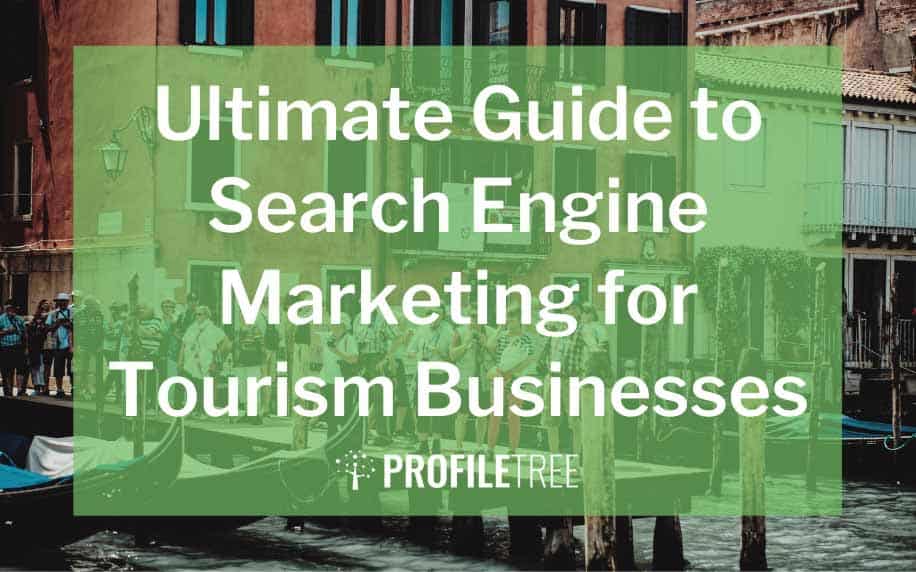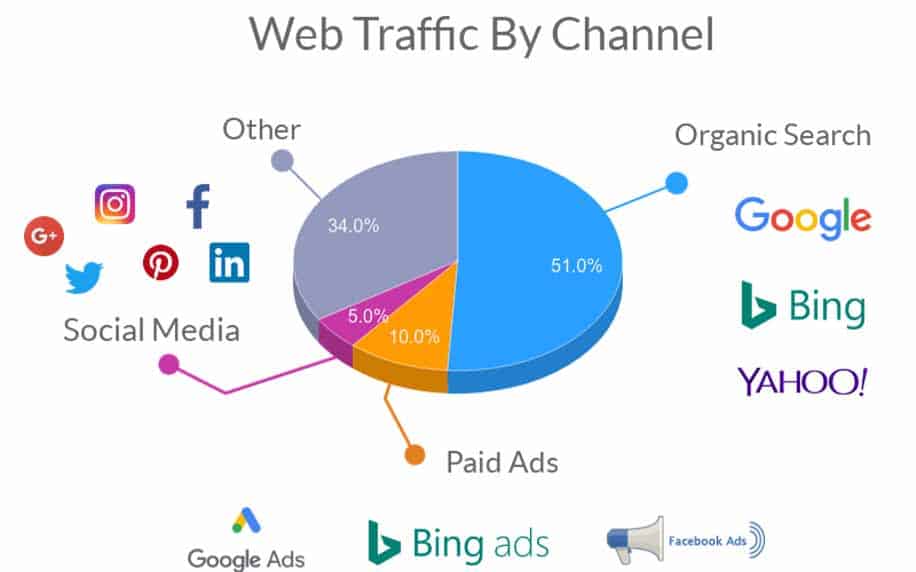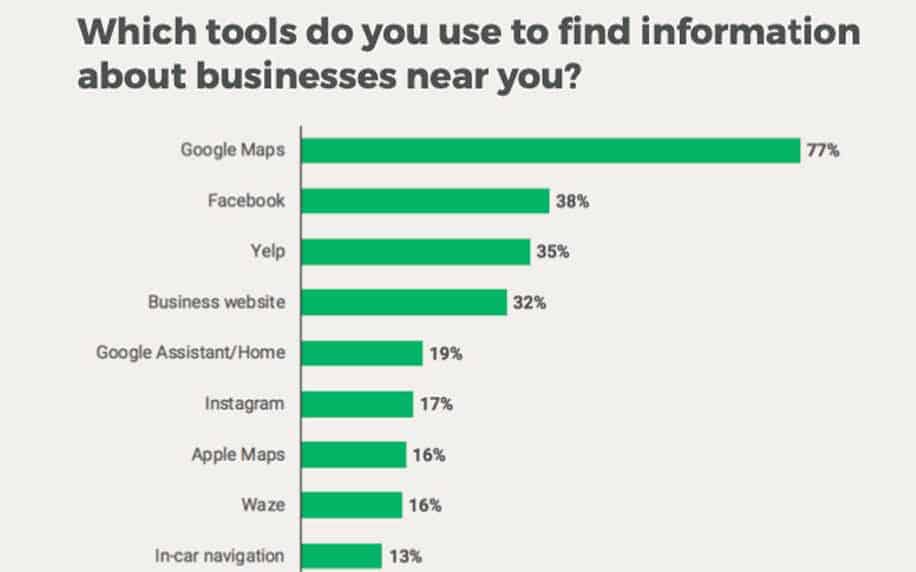Tourism businesses rely on the internet to reach new customers. Most people research their trips and holidays online before they leave home. As such, it’s crucial to understand search engine marketing for tourism businesses.
The trouble is, tourism businesses have a lot on their plate. Many operate with small teams, doing everything from managing accounts, providing tours and handling customer service. This means that it’s hard to find time for marketing as well.
This is a big problem for any small business, as there’s a massive learning curve involved with any new marketing activity. To make things easier, we’ve created this guide to search engine marketing for tourism businesses.
First, let’s start with the basics.
Table of Contents
What is Search Engine Marketing for Tourism Businesses
Search engine marketing (SEM) is a broad term, comprising any strategy to attract new customers through search engines, like Google. This can include SEO, paid ads, and taking advantage of other more specific Google products and features.

Importantly, the vast majority of web traffic across all industries comes from search engines in one form or another:

Additionally, other traffic sources typically come in to play later in your sales funnel. That is, most of your first-visit traffic normally comes from SEM, while other channels like social or email begin to drive traffic once users are already aware of your brand.
This effect is amplified for tourism businesses. The reason for this is that your target first-visit users are usually in other towns, cities or countries. As such, effective SEM in the tourism industry is absolutely critical.
In this guide, we’re going to outline a two-pronged approach, using a mixture of Google Maps and content marketing. This is the most cost-effective way to build a strong SEM foundation, as PPC can often offer a poor return on investment.
First up, let’s look at how you can utilise Google Maps and Google My Business to drive tourism traffic.
Google Maps and Local SEO for Tourism Businesses
Google Maps is sort of an unsung hero of SEO and search engine marketing. It’s a real local SEO powerhouse, but most people underestimate the volume of traffic which can be accessed through this platform.
Even better, effective SEM through Google Maps takes almost no effort.
The crux here is that Google Maps is the top channel for users seeking information through locally modified keywords. In other words, when people are seeking information relating to a particular location, Google Maps is their first port of call:

The key is to focus your SEM and local SEO around taking advantage of this fact. Let’s take a look at some of the steps you can take to achieve this.
Optimise your Google My Business Profile
Google My Business is a free business listing and directory service. This might sound a little dry, but it has a huge impact on how your site attracts visitors. The key to understanding why is thinking about Google’s business model.
Essentially, Google’s goal is to match users to the information they’re looking for. How effectively they can do this depends on what information they have about your business. Google My Business lets you give them the info they need in a neat little package.
This includes crucial information about your business like:
- Name,
- Address,
- Contact details,
- Opening hours,
- Services.
The first rule here is to ensure that these are fully present, accurate, and up to date. It’s also important that your Google My Business data is consistent with the information in other online directories.
Once you have these things in place, you can then start seeking out similar citations from other major online directories to boost the credibility of your Google My Business profile.
Following these steps will help your business to be displayed more prominently in local searches. However, there is still work to be done. That is, once you’ve got to the top of Google Maps and the local SERPs, it’s time to start thinking about maximising click-throughs.
Here are two of the most effective strategies you can use to do this as a tourism business.
Encourage Customer Reviews
The key here is making your Google Maps and Google My Business presence as enticing as possible to users. This is where you need to start using your creative marketing skills. One of the best ways to do this is using social proof and FOMO marketing.
Essentially, most people trust their peers more than they trust marketing departments. Social proof is all about leveraging this fact to gain more customers for your products and services. To do this you need to use stories from previous clients to show off how much they loved your business.
The easiest way to do this is to encourage them to leave reviews at the point of sale or service delivery. The better your overall review profile, the better the chance you’ll have of attracting customers.
Users’ fear of missing out also comes into play here. When people read stories of others having amazing experiences, this makes them more inclined to book a tour, as they’re afraid of missing out on experiencing it for themself.
Customer Questions and Answers
Google Maps also provides a very helpful question and answer section. However, many businesses fail to take advantage of this, because they don’t understand the benefits on offer.
They might also have practical concerns.
Fully optimising your Google My Business profile will only get you so far. At least, it will help you cover basic information, but some users will have more specific queries. For example, if your business can accommodate certain disabilities or dietary requirements
Responding to customer queries on Google My Business is a great way to get around this. Even better, responding to queries projects the image of a business that cares about its customers, which can help to improve conversions.
Content Marketing

The second stream of your search engine marketing strategy will involve creating a mixture of on-site and off-site content to attract users for your tourism business. Different content channels can have a massive impact on the success of search engine marketing for tourism businesses.
Specifically, we’re going to look at three easy to implement strategies you can start using to improve your SEM traffic.
Let’s go.
Blogging for Tourism Businesses
Blogging is one of the most cost-effective ways for businesses in any niche to reach new customers. This is because using a blog is such a cheap and easy way to write content for search engines.
This is also a great chance to target customer concerns and queries. Creating content for your blog is all about identifying common search terms relating to your business or industry, and publishing articles that meet the needs of these users.
This requires a process of keyword research, in order to determine the search queries you should target, as well as what users are hoping to achieve when they search for these terms.
Video Content Strategy
Another great SEM content strategy is creating high-quality videos relating to your business, and what it has to offer. While this strategy requires more initial investment than blogging, you can also expect to see an excellent return on investment.
There are a number of huge benefits to using a video content strategy.
More searches than ever include a video carousel above the primary results list. Additionally, these spots are less competitive, as many businesses don’t invest in video content at all. This means it’s much easier for video content to rank highly.
Additionally, featured snippets in the SERPs often prioritise blog articles with embedded videos, meaning that creating video content is an easy way to secure the zero position for search queries, especially for keywords seeking out specific information or questions.
Finally, video content can be repurposed for use on other marketing channels. Specifically, you can use your videos to great effect as email, social and PPC collateral. This means it’s easy to safeguard the ROI of your video content strategy.
User-Generated Content
As the name suggests, user-generated content is anything that is created by your customers. This can include photos, reviews, blogs and even social media posts. This is a cheap and easy way to get your name out there.
You basically don’t have to lift a finger.
The key is ensuring that you have a presence on the right platforms to take advantage of user-generated content. For tourism businesses these include:
- Social networks, especially Facebook and Instagram,
- Review sites, like TripAdvisors,
- Booking platforms that advertise experiences.
For small tourism businesses, it’s generally best to centre your user-generated content strategy on known platforms. The reason for this relates to their domain authority. In terms of SEO, high authority sites have a much better chance of ranking than lower ones.
This means you’ll likely have trouble competing with the major players on some generic tourism-related search terms. For example, TripAdvisor is in a much better position to rank for a term like Kayak tours Northern Ireland, than a small local watersports company.
As they say, if you can’t beat ‘em, join ‘em.
Accepting this, your best bet is to try and take advantage of TripAdvisor’s high ranking for your desired terms. User-generated content, in the form of reviews, photos and stories helps to do this. Specifically, it achieves two things:
- Funnels referral traffic to your site,
- Creates natural backlinks, which improves your site’s domain authority.
It’s easy to encourage user-generated content, either through online marketing channels or when you’re face to face with your customers.
Leveraging the Power of Social Media: Engaging with Travelers
Social media isn’t just a platform for broadcasting messages; it’s a vibrant space to connect with potential travelers, build relationships, and fuel their wanderlust. But with so many platforms vying for attention, choosing the right ones and engaging your audience effectively is crucial. Here’s how:
1. Choose the Right Platforms:
Before diving in, understand your target audience and travel niche. What kind of travelers are you trying to reach? Are they adventure seekers on Instagram, budget-conscious backpackers on Pinterest, or luxury travelers on Facebook? Research which platforms resonate most with your target audience:
- Instagram: Ideal for visually stunning destinations, travel experiences, and user-generated content. Perfect for adventure travel, luxury escapes, and visually-driven niches.
- Facebook: Diverse platform for sharing longer stories, engaging in discussions, and running targeted ads. Good for family vacations, cultural experiences, and historical destinations.
- Twitter: Real-time platform for sharing quick updates, travel tips, and engaging in conversations. Suitable for budget travel, flash deals, and trendy destinations.
- Pinterest: Inspiration board for travel planning and dream destinations. Perfect for visually appealing content, travel guides, and itinerary inspiration.
- YouTube: Immersive platform for showcasing travel vlogs, destination videos, and behind-the-scenes glimpses. Ideal for adventure travel, cultural experiences, and unique destinations.
Remember, don’t spread yourself thin. Choose 2-3 platforms where you can be truly active and engaged.
2. Go Beyond Posting: Spark Engagement and Build Relationships:
Passive posting isn’t enough. To truly captivate travelers, you need to interact and build relationships. Here are some strategies:
- Interactive Content: Ask questions, run polls, host live Q&As, and encourage user-generated content like travel photos or destination recommendations.
- Contests and Giveaways: Offer exciting prizes related to travel experiences, accommodation, or local products to generate buzz and attract new followers.
- Collaborate with Influencers: Partner with travel influencers in your niche to tap into their established audience and gain credibility. Ensure alignment with your brand values and target audience.
- Respond to Comments and Messages: Promptly and personally respond to inquiries, feedback, and questions to show you care and build trust.
- Host Live Events: Host live streams from destinations, interviews with local experts, or virtual tours to create a sense of community and excitement.
- Utilize Stories and Reels: Leverage these features for short, engaging snippets of travel content, behind-the-scenes glimpses, and quick updates.
3. Utilize Social Media Advertising: Reach the Right Travelers at the Right Time:
Social media advertising allows you to target specific traveler segments based on demographics, interests, travel behavior, and even location. This laser-focused targeting ensures your message reaches the ideal audience, maximizing your ad spend and attracting qualified leads.
- Highlight Special Offers and Deals: Target ads showcasing exciting promotions, packages, or last-minute deals to travelers actively searching for travel options.
- Promote Specific Destinations or Experiences: Tailor ad campaigns to specific destinations or activities based on user interests and travel preferences.
- Retarget Website Visitors: Capture website visitors who haven’t booked yet and entice them with targeted ads reminding them of your offerings.
- Lookalike Audiences: Utilize platform features to reach new audiences with similar characteristics to your existing customer base.
Remember: Social media is a journey, not a destination. Be patient, experiment with different strategies, track your results, and adapt your approach to keep your audience engaged and interested. By leveraging the power of social media effectively, you can turn online interactions into real-life bookings and build a loyal community of passionate travelers around your brand.
Building Relationships with Email Marketing: Beyond the Inbox
Forget generic blasts sent to everyone on your list. Today’s savvy travelers crave personalized experiences, and email marketing offers a powerful platform to cultivate meaningful connections and nurture leads through the travel journey. Here’s how:
1. Personalization is Key: Segmenting Your Audience for Impact:
Imagine sending the same email promoting family resorts to solo adventure seekers. It wouldn’t resonate, right? That’s why segmentation is crucial. Divide your email list into groups based on:
- Demographics: Age, location, income, etc.
- Interests: Travel style, preferred destinations, activities, etc.
- Travel preferences: Budget, luxury vs. budget-friendly, family travel, etc.
- Past behavior: Website visits, booking history, email engagement, etc.
By sending targeted emails tailored to each segment’s specific needs and desires, you increase engagement, open rates, and ultimately, conversions.
2. Nurturing Leads Through the Travel Funnel: A Guided Journey to Booking:
Travelers rarely book impulsively. They research, compare, and dream before making a decision. Email automation allows you to nurture leads at each stage of the funnel with relevant and timely messages:
- Welcome emails: Set the tone, introduce your brand, offer valuable resources like travel guides or destination tips.
- Inspiration emails: Showcase stunning visuals, highlight exciting experiences, share customer testimonials to fuel travel dreams.
- Educational emails: Offer destination guides, packing tips, cultural insights, answer frequently asked questions to build trust and expertise.
- Promotional emails: Share targeted deals, limited-time offers, personalized recommendations based on their interests and browsing behavior.
- Re-engagement emails: Reach out to inactive subscribers with exclusive offers or remind them about their abandoned cart.
Remember, automation doesn’t mean impersonal. Utilize dynamic content to personalize email elements like names, destinations, and offers, making them feel relevant and special.
3. Seamless Integration: Weaving Email into Your Marketing Fabric:
Email marketing doesn’t exist in a silo. Integrate it seamlessly with your other marketing channels for a unified customer experience:
- Social media: Capture email sign-ups through social media contests, offer exclusive email content to followers, and share snippets of your email campaigns on social platforms.
- Website: Promote email sign-ups on your website, integrate lead capture forms, and personalize website content based on subscriber segments.
- Paid advertising: Use retargeting ads to reach website visitors who haven’t subscribed yet and entice them with email-specific offers.
- Influencer marketing: Collaborate with travel influencers to promote your email list sign-up through their blog posts, social media content, or video descriptions.
Remember, track your email marketing performance closely. Analyze open rates, click-through rates, and conversion rates to understand what resonates with your audience and refine your strategy for even better results.
Bonus Tip: Utilize A/B testing to compare different subject lines, content formats, and calls-to-action to identify what resonates best with your audience and continuously optimize your email campaigns for maximum impact.
By prioritizing personalization, nurturing leads through the travel funnel, and integrating email with other marketing channels, you can transform your email marketing into a powerful relationship-building tool that drives bookings and fosters long-term customer loyalty for your travel business.
Measuring Your Marketing Journey: From Clicks to Conversions
In the dynamic world of travel and tourism marketing, understanding the impact of your efforts is crucial. Tracking data and analyzing key performance indicators (KPIs) allows you to optimize your strategy, maximize your budget, and, ultimately, drive more bookings. Let’s delve into the metrics that matter and how to use them effectively:
1. Defining Your KPIs: Charting Your Course:
KPIs are the measurable benchmarks that gauge the success of your marketing efforts. Each business has unique goals, so choosing the right KPIs is vital. For travel and tourism, consider these key areas:
- Website Traffic:
- Unique Visitors: Number of individual users visiting your website.
- Pageviews: Total number of pages viewed on your website.
- Session Duration: Average time users spend on your website.
- Bounce Rate: Percentage of visitors leaving after viewing one page.
- Engagement:
- Click-Through Rate (CTR): Percentage of users who click on a specific link, e.g., in ads or emails.
- Social Media Engagement: Likes, comments, shares, and messages on your social media platforms.
- Email Open Rates & Click-Through Rates: Percentage of email recipients who open your email and click on links within it.
- Conversions:
- Leads Generated: Number of potential customers who submit contact information through forms or inquiries.
- Bookings: Number of travel bookings made through your website or other channels.
- Revenue Generated: Total sales generated from your marketing efforts.
2. Tracking & Analyzing: Deciphering the Data Landscape:
Utilize analytics tools like Google Analytics and social media platform insights to track your KPIs. But simply collecting data isn’t enough. You need to analyze it effectively:
- Segmentation: Segment your data by campaign, platform, audience, or other criteria to understand where your performance shines and where it needs improvement.
- Benchmarking: Compare your results to industry benchmarks or past performance to gauge your progress and identify areas for improvement.
- Attribution Modeling: Understand which marketing channels and touchpoints contribute most to conversions, allowing you to allocate resources effectively.
- Funnel Analysis: Analyze each stage of the travel booking funnel (awareness, interest, consideration, decision, booking) to identify bottlenecks and optimize conversion rates.
3. Data-Driven Decisions: From Insights to Action:
Turn your data insights into actionable strategies:
- Double down on what works: Identify successful campaigns, content formats, and platforms based on data and invest more resources in them.
- Refine your strategy: Address underperforming areas by testing new approaches, experimenting with different content formats, or optimizing your website based on user behavior data.
- Personalize your approach: Leverage data to segment your audience further and personalize your marketing messages for better engagement and conversion.
- Allocate resources wisely: Utilize data-driven insights to make informed decisions about budget allocation across different marketing channels and campaigns.
Remember, measurement is an ongoing process. Regularly monitor your KPIs, analyze your data, and adapt your strategy based on insights to ensure your marketing efforts are effective, efficient, and aligned with your goals.
Bonus Tip: Utilize A/B testing to compare different approaches, such as ad copy, website layouts, or email subject lines, and identify what resonates best with your audience for continuous improvement.
By measuring your marketing journey from clicks to conversions, you can make data-driven decisions that optimize your strategy, maximize your return on investment, and ultimately, attract more travelers ready to book their dream vacation with you.
Tourism Businesses FAQ:
Q: What are the biggest benefits of using SEM for my tourism business?
A: Increased website traffic, brand awareness, targeted leads, higher booking rates, and improved ROI.
Q: How long does it take to see results from SEM?
A: It depends on your specific goals, competition, and budget. Expect 3-6 months for consistent, measurable results.
Q: How much does SEM cost?
A: Costs vary depending on your needs, budget, and chosen agency. Expect a range of $500-$5,000+ per month.
Q: What should I look for in an SEM agency for tourism businesses?
A: Industry experience, proven track record, transparent pricing, focus on travel-specific strategies, and good communication.
Q: Can I do SEM myself?
A: While possible, it requires time, expertise, and ongoing effort. Partnering with an agency can save time, increase your chances of success, and offer valuable insights.
Tourism Businesses Conclusion:
Travelers today are savvy digital consumers, turning to search engines for inspiration, planning, and booking their dream vacations. Ignoring search engine marketing (SEM) in today’s landscape is like having a hidden gem with no map – potential travelers won’t find it. Implementing effective SEM strategies tailored to the travel industry can unlock immense potential, attracting qualified leads, driving bookings, and propelling your business towards success. By understanding your target audience, leveraging emerging trends, and utilizing data-driven approaches, you can navigate the ever-evolving search landscape and create a winning SEM strategy.
Remember, the journey begins with a single search, and your business can be the answer waiting to be discovered. Don’t miss out on the opportunity to connect with travel-ready audiences and turn their online searches into real-life bookings. Start your SEM journey today!



Nicely written page. I honestly like the subject matter covered here. I’ll come back every now and then for more posts like this one.